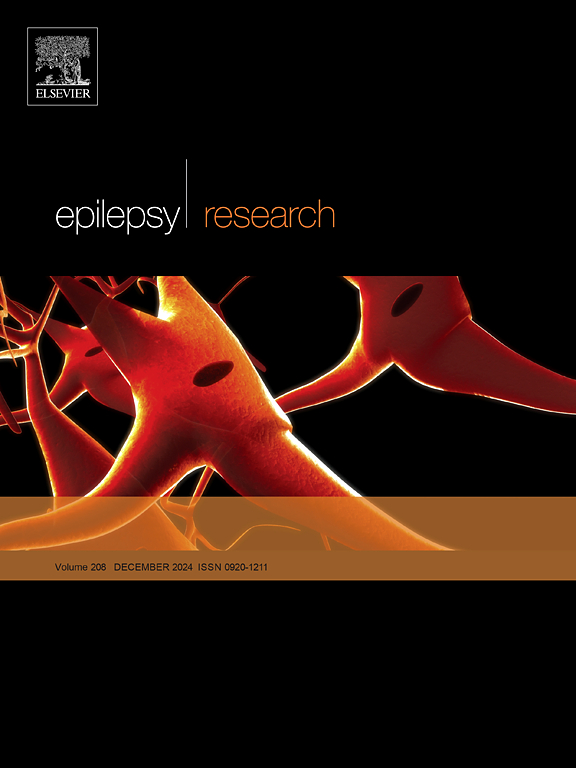Enteral topiramate treatment in refractory status epilepticus
IF 2
4区 医学
Q3 CLINICAL NEUROLOGY
引用次数: 0
Abstract
Objective
Refractory status epilepticus (RSE) is defined as persistent seizure activity despite first- and second-line antiepileptic medications (ASMs). Although benzodiazepines and a range of iv ASMs are available, mortality is 3–4 times higher than in those without RSE. Topiramate (TPM), a broad-spectrum ASM, may have neuroprotective, anti-inflammatory, and mitigating effects on neuronal injury. We aimed to investigate the efficacy of TPM and mortality in RSE.
Methods
This retrospective, multicentre study was conducted on RSE ≥ 18 years of age in six different universities and state hospitals in Ankara and Istanbul, Turkey. Demographic data, seizure classification and etiology were analyzed. TPM was loaded and a maintenance dose was scheduled. The outcomes, prognoses, comorbidities were analysed. The effectiveness of TPM and mortality rates of the patients were also analyzed.
Results
The study includes 60 patients with a mean age of 51.6 (±20, 20–84) years, 46.7 % were women. The patients were classified as having convulsive SE or nonconvulsive SE. TPM was performed as median third order ASM. The loading dose varied between 200 and 500 mg bid. The dose was subsequently reduced and maintained at 100–200 mg/day. There were 6 patients in whom TPM could not be continued due to adverse effects. TPM was considered successful in 22 patients, possibly successful in 23 patients and unsuccessful in 15 patients. Thirty-three patients were discharged from hospital, 8 were transferred to a rehabilitation center, 4 were transferred to a palliative care center and 13 died. There was no effect of age, gender, whether intubation was performed or not, etiologic classification, SE type (convulsive or nonconvulsive), duration of TPM administration, TPM loading dose on TPM success. Patients with RSE who were successfully treated with TPM had shorter hospital stays. The mortality predicting variables were determined as older age, not having epilepsy, failure to terminate RSE and acute symptomatic etiology.
Significance
This observational, multicenter study indicates that enteral TPM therapy is well tolerated, has a favorable safety profile, and is effective in patients with RSE. This is the first study in the literature to end SE with both high and low dose oral TPM treatment.
难治性癫痫持续状态的肠内托吡酯治疗
目的:难治性癫痫持续状态(RSE)被定义为尽管一线和二线抗癫痫药物(asm)仍持续发作活动。虽然可以使用苯二氮卓类药物和一系列静脉注射抗抑郁药,但死亡率比没有RSE的患者高3-4倍。托吡酯(TPM)是一种广谱ASM,可能具有神经保护、抗炎和减轻神经元损伤的作用。我们的目的是探讨TPM在RSE中的疗效和死亡率。方法本回顾性多中心研究在土耳其安卡拉和伊斯坦布尔的6所不同的大学和国立医院对RSE≥ 18岁的患者进行研究。分析人口学资料、癫痫分型及病因。加载TPM并计划维护剂量。分析结果、预后、合并症。分析了TPM的有效性和患者的死亡率。结果本组患者60例,平均年龄51.6(±20,20 - 84)岁,女性46.7 %。患者分为惊厥性SE和非惊厥性SE。TPM作为中位数三阶ASM进行。负载剂量在200 ~ 500 mg bid之间变化。随后减少剂量并维持在100-200 mg/天。6例患者因不良反应不能继续进行TPM。22例患者认为TPM成功,23例可能成功,15例不成功。33名患者出院,8人转至康复中心,4人转至姑息治疗中心,13人死亡。年龄、性别、是否插管、病因分类、SE类型(惊厥型或非惊厥型)、TPM给药时间、TPM负荷剂量对TPM成功无影响。采用TPM成功治疗的RSE患者住院时间较短。死亡率预测变量确定为年龄较大、未患癫痫、未能终止RSE和急性症状性病因。这项多中心观察性研究表明,肠内TPM治疗耐受性良好,具有良好的安全性,并且对RSE患者有效。这是文献中首次以高剂量和低剂量口服TPM治疗结束SE的研究。
本文章由计算机程序翻译,如有差异,请以英文原文为准。
求助全文
约1分钟内获得全文
求助全文
来源期刊

Epilepsy Research
医学-临床神经学
CiteScore
0.10
自引率
4.50%
发文量
143
审稿时长
62 days
期刊介绍:
Epilepsy Research provides for publication of high quality articles in both basic and clinical epilepsy research, with a special emphasis on translational research that ultimately relates to epilepsy as a human condition. The journal is intended to provide a forum for reporting the best and most rigorous epilepsy research from all disciplines ranging from biophysics and molecular biology to epidemiological and psychosocial research. As such the journal will publish original papers relevant to epilepsy from any scientific discipline and also studies of a multidisciplinary nature. Clinical and experimental research papers adopting fresh conceptual approaches to the study of epilepsy and its treatment are encouraged. The overriding criteria for publication are novelty, significant clinical or experimental relevance, and interest to a multidisciplinary audience in the broad arena of epilepsy. Review articles focused on any topic of epilepsy research will also be considered, but only if they present an exceptionally clear synthesis of current knowledge and future directions of a research area, based on a critical assessment of the available data or on hypotheses that are likely to stimulate more critical thinking and further advances in an area of epilepsy research.
 求助内容:
求助内容: 应助结果提醒方式:
应助结果提醒方式:


